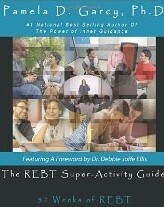REBT guide useful in meetings or on your own
Ana Troncoso – Meeting Facilitator, Phoenix, AZ
 Dr. Pamela D. Garcy’s book, The REBT Super-Activity Guide: 52 Weeks of REBT, promises “success strategies to help you shift out of unhealthy emotions and into action,” and it largely delivers.
Dr. Pamela D. Garcy’s book, The REBT Super-Activity Guide: 52 Weeks of REBT, promises “success strategies to help you shift out of unhealthy emotions and into action,” and it largely delivers.
To apply the exercises from the workbook in several settings, I used the book both as a resource for techniques that could be introduced during SMART Recovery® (SMART) meetings, and as a tool for things I could do on my own, at home, in a less formal setting.
While the book’s intended audience is wide, it may be overwhelming for someone trying to do this type of therapeutic work on their own. I think the individual who already has a strong base in the concepts of Rational Emotive Behavior Therapy (REBT) may appreciate this book the most. Someone who is receiving some type of formal guidance as they learn about the REBT approach will also probably get the most benefit from the book.
The book is thoughtfully organized. Dr. Garcy mentions that it can be read in order or by skipping around. Because I was often looking for strategies that fit a particular situation, I skipped around, using the table of contents as my primary roadmap. The table of contents is a resource in and of itself; I frequently found myself scanning it just to get a quick REBT primer.
Each of the 52 weeks is given its own chapter, and though each chapter is two to four pages long, they are packed with information. The format presents an overview of the topic, then provides an approach to the topic from an REBT perspective. Dr. Garcy often references Dr. Ellis in this section. At the end of each chapter, she presents one or more action steps to illustrate the concepts she introduced.
Some examples of chapter titles include:
• Is this a Preference or a Demand?
• Setting Anti-Mustubatory Goals
• What Can You Change?
• How Can I Dispute That?
• Anti-Awfulizing Exercises
• Accepting Ambiguity and Uncertainty
• Anti-Procrastination
The very first activity I used from the book came from Chapter 8, “Why Whining Isn’t Good for You.” It includes one exercise broken down into several action steps. First, you’re asked to make a list of 10 things you whine about. Next, you’re asked to write down something that you tell yourself about each of those things. Next, you review your original list, and write down what you could be telling yourself if you adopt a “NO WHINING” policy. Finally, you create a list of five reasons you don’t want to whine anymore and why, instead, you’re going to start solving your problems.
This was a great activity to do in a meeting because it enabled us to brainstorm and to laugh at some over-the-top suggestions. I was pleased at how it helped to bring a room of relative strangers together, and I was delighted with the participants’ reactions. They were engaged and genuinely stimulated.
The second activity I used in a SMART meeting also came from Chapter 8, although I used it in a different context. In this chapter, Dr. Garcy tells the reader “Whining is debilitating. Whining shuts you down. Whining blinds you from looking at what you can control…” I wrote these sentences on our whiteboard, only I replaced the word “whining” with the word “worry.” This was an effective starting point for a discussion about anxiety.
Another chapter that I found particularly helpful in a SMART meeting was Chapter 13, “Understanding Some of the IBs (irrational beliefs) of Unhealthy Anger.” This chapter draws a parallel between being drunk and being angry, which was a useful analogy to lead into a conversation about anger and some of its effects. Three action steps are included in this chapter, one of which asks the reader to “identify all the demands behind your anger” by writing down their beliefs and underlining the “shoulds, musts, have tos, ought tos, need tos” they’re allowing themself to believe. Again, this brainstorming exercise kept the group’s energy high and teased out some of the demands participants had been making in their lives.
Finally, Chapter 35 had a strong impact on me, “Working on Acceptance of the Self.” Dr. Garcy tells the reader to
“…think of someone that you love unconditionally. It could be a friend, a relative, a baby, or an animal….Pretend this special someone made a mistake of some kind. List 10 things that you would say in order to express your unconditional love….Now…say them to yourself out loud.”
I often use a suggestion similar to this one when I sense that someone is feeling great shame or guilt, and is looking for a way to forgive themselves, or simply when they would benefit by being kind to themselves. However, until I read Dr. Garcy’s book, I’d never had a tool that allowed me to demonstrate this idea in a tangible way, nor had I ever taken the time to do this for myself. Since then, it’s an exercise I turn to weekly, with excellent results.
I’m grateful that I had the opportunity to read Dr. Garcy’s book and share my experiences with a new audience. The Activity Guide will be a resource for any facilitators looking for tools they can use in a group to increase crowd participation and stimulate brainstorming sessions. Participants can then do the action steps on their own to reinforce the skills they’re learning in group or with their counselors.
I highly recommend The REBT Super-Activity Guide.
